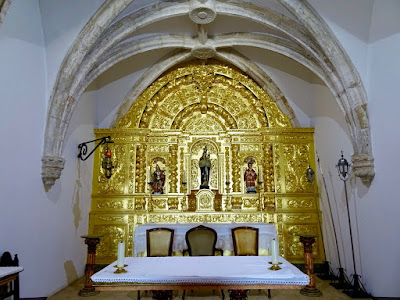We are in Praia de Luz. A tribute to a local worthy suggests it once looked more or less like this.
A backwater inhabited by a few fishermen no longer. Possibly just as well as my 1875 travel guide warns its doubtless very proper Victorian readers that ‘… the olfactory nerves of the traveller will be sadly taxed in (the Algarve’s) towns and in its sea ports, especially at low tide, for then everything near the sea-side (sic) is execrable’.
Descendants of the guidebook’s readers, who once considered travel in Portugal such an adventure, have descended here in numbers sufficient to create more real estate offices than I’ve seen in one small town.
That said, Luz is still somewhat less developed than elsewhere on the Algarve. And it’s certainly quiet in this, the low season.
Luz’s beach is quite wonderful …
… and I can easily count the few visitors.
I’ve taken to occasional early morning walks taking me past the church, Nossa Senhora da Luz (Our Lady of Light). The 16th Century building was badly damaged in the 1755 earthquake. Not only was Lisbon famously devastated, there was major destruction on the Algarve.
I’m reminded of Voltaire’s Candide from school? university? It was written following the quake and criticized the concept that all is for the best in this ‘the best of all possible worlds’. The earthquake had a major impact on the European Enlightenment, attacked, of course, by the Church.
By standards in these parts, Nossa Senhora da Luz is unadorned with a white interior and modern stained glass. No gory relics. Perhaps the simplicity is why it’s also used by local Anglicans. Or it’s just hard up and has seized on Protestant support.
As the sun peeks over the Rocha Negra (Black Rock) headland …
… I am alone on the promenade.
Businesses await summer hordes.
The town is quiet …
… and I have the Café Habana to myself.
By the time I’ve paid my bill, the first beachgoers are starting to appear …
… and, not long after, elderly expats (come to think of it, I’m one) have plunked themselves on promenade benches …
… while I examine the delightful calçada Portuguesa, Portuguese paving. Designs made from blocks of white limestone and black basalt may have their origin in Roman mosaics.
Luz offers occasional quirky charms. I chance on the Casa Chiquita Banana, a touch down-at-heels, but ‘definitely has potential’ as local real estate people would doubtless claim.
Ceramic bananas decorate the mailbox. Once the property of an English couple with a sense of humour?
Another building, now gutted, is this extraordinary attempt at small town modernism …
… with portholes …
… and curious streamlining.
But what really stands out is the building’s ribbon of decorative, broken tiles.
More recent is this building, housing a restaurant, with domes a nod to Portugal’s Moorish past.
Another morning, I wander the town cemetery and find two foreign graves of interest.
One has a touching sculpture, a cat eternally resting on the slab covering a British couple.
The other, of Joshua Menkes originally from Vienna, has dolphins. Is the name Jewish? Yes, it could be. Following the Anschluss did he flee the Germans and Austrians, and find refuge in Portugal? Did he stay after 1945 or perhaps return in later life and find happiness with the dolphins of the Algarve coast? It would be nice to think Mr. Menkes did.




























